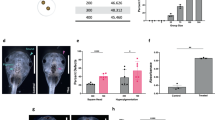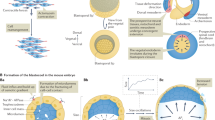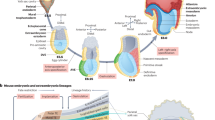Abstract
In many embryos, the removal of cells whose descendants would normally have formed entire parts of the body pattern Is followed by apparently normal morphogenesis, which implies an ordered readjustment of the activities of the remaining cells before their potentialities become restricted. Special cell lineages cannot underly the generation and regulation of pattern in such embryos1,2. It is proposed instead that there must be some regulatory communication system in the developing embryo that normally ensures an appropriate spatial pattern of differentiation but which is also able to adjust to the removal, addition or transposition of material at a sufficiently early stage3–6. Precise models for such a mechanism have recently been suggested6–10, and have been tested experimentally10–14. I have performed surgical manipulations at pre-gastrula embryonic stages in two distantly related amphibian types, Xenopus and Ambystoma, and report here an assessment of the regulation achieved in terms of pattern proportions. The results are problematical for most current theories of pattern control.
This is a preview of subscription content, access via your institution
Access options
Subscribe to this journal
Receive 51 print issues and online access
$199.00 per year
only $3.90 per issue
Buy this article
- Purchase on SpringerLink
- Instant access to full article PDF
Prices may be subject to local taxes which are calculated during checkout
Similar content being viewed by others
References
Dan-Sohkawa, M. & Sato, N. J. Embryol. exp. Morph. 46, 171–185 (1978).
Cooke, J. J. Embryol. exp. Morph. 51, 165–182 (1979).
Driesch, H. The Science and Philosophy of the Organism, 2nd edn (Black, London, 1929).
Weiss, P. Q. Rev. Biol. 15, 177–198 (1950).
Waddington, C. H. J. exp. Biol. 15, 377–381 (1938).
Wolpert, L. J. theor. Biol. 25, 1–48 (1969).
Goodwin, B. C. & Cohen, M. H. J. theor. Biol. 25, 49–107 (1969).
Gierer, A. & Meinhardt, H. Kybernetik 12, 30–39 (1972).
Meinhardt, H. Rev. physiol. biochem. Pharmac. 80, 47–104 (1978).
Tickle, C., Summerbell, D. & Wolpert, L. Nature 254, 199–202 (1975).
Wolpert, L., Clarke, M. R. B. & Hornbruch, A. Nature 239, 101–105 (1972).
Summerbell, D. J. Embryol. exp. Morph. 50, 217–233 (1979).
Cooke, J. J. Embryol. exp. Morph. 28, 13–26, 27–46, 47–56 (1972); 30, 283–300 (1973).
Herth, W. & Sander, K. Arch. EntwMech. Org. 172, 1–27 (1973).
Forman, D. & Slack, J. M. W. Nature 286, 492–494 (1980).
Keller, R. E. Devl. Biol. 51, 118–137 (1976).
Spemann, H. & Mangold, H. Arch. microsk. Anat. EntwMech. 100, 599–638 (1924).
Summerbell, D. & Wolpert, L. Nature 244, 228–229 (1973).
Sibatani, A. J. theor. Biol. 75, 149–166 (1978).
Papageorgiou, S. Biophys. Chem. 11, 183–198 (1980).
Cooke, J. Am. Zool. (in the press).
Rose, S. M. Growth 31, 149–164.
Meinhardt, H. & Gierer, A. J. theor. Biol. 85, 429–450 (1980).
Cooke, J. Nature 254, 196–199 (1975).
Author information
Authors and Affiliations
Rights and permissions
About this article
Cite this article
Cooke, J. Scale of body pattern adjusts to available cell number in amphibian embryos. Nature 290, 775–778 (1981). https://doi.org/10.1038/290775a0
Received:
Accepted:
Issue date:
DOI: https://doi.org/10.1038/290775a0
This article is cited by
-
Darwin’s agential materials: evolutionary implications of multiscale competency in developmental biology
Cellular and Molecular Life Sciences (2023)
-
Modeling somatic computation with non-neural bioelectric networks
Scientific Reports (2019)
-
Malignant Melanoma: Autoimmunity and Supracellular Messaging as New Therapeutic Approaches
Current Treatment Options in Oncology (2019)
-
Segmentation within scale
Nature (2013)
-
Scaling of BMP gradients in Xenopus embryos
Nature (2009)



